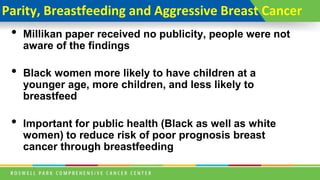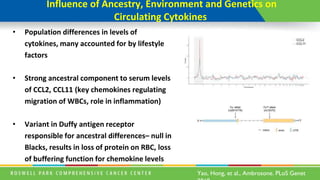Aggressive Breast Cancers in Black Women
- 1. Christine Ambrosone, PhD Song Yao, PhD Aggressive Breast Cancers in Black Women
- 2. Breast Cancer in Black Women 2 Increase Team Science Project • Historically, breast cancer rates in the US were highest in white women, but rates have been changing, with more breast cancer experienced by Black women • More Black women die from breast cancer than other groups in the US
- 3. Breast Cancer Incidence and Death in US 3 Increase Team Science Project
- 4. Breast Cancer in Black Women 4 Increase Team Science Project • Some of higher mortality may be due to less access to screening (later stage at diagnosis), and less access to best possible treatments • Black women more often diagnosed with tumors that are more aggressive, and have worse outcomes – Lack receptors for estrogen (ER), progesterone (PR) and HER2 (Triple Negative Breast Cancer (TNBC)) – No targeted therapies available for TNBC, such as tamoxifen and aromatase inhibitors
- 5. Breast Cancer Subtypes in the US 5 Increase Team Science Project
- 6. 6 Why are these aggressive breast cancers more common in Black women??
- 7. Funded by: DOD DAMD17-01-1-0334 (2001-2006) NCI R01 CA 100598 (2003 – 2011) Breast Cancer Research Foundation (2008- ) NCI P01 CA151135 (2011 – 2016) Women’s Circle of Health Study Christine Ambrosone, PhD Elisa Bandera, MD, PhD (CINJ)
- 8. • In the past, majority of studies examined overall breast cancer risk, not by ER status • Studies were conducted mainly in populations of older white women (@90% are ER+) – so ‘known’ risk factors apply primarily to ER+ disease • It was unknown if risk factors differed by ER status, or if there were differing risk factor profiles for Black women Risk factors for aggressive breast cancer
- 9. Increased risk with: • Family history of breast cancer • Radiation exposure (atom bomb, radiation treatment to the chest) • Hormone replacement therapy • Alcohol consumption • Overweight in postmenopausal women • Sedentary behavior (low physical activity) What do we know about causes of breast cancer?
- 10. Reduced risk with: • Later age at menarche • Having children (parity) – Earlier age at first birth • Early age at menopause Reproductive Risk Factors
- 11. Parity and Breast Cancer Subtypes Case-control analysis Luminal A (ER+) OR (95% CI) Basal-like (TNBC) OR (95% CI) No children 1 2 3+ 1.0 0.7 (0.5-1.0) 0.7 (0.6-1.0) 0.7 (0.5-0.9) 1.0 1.7 (0.9-3.0) 1.8 (1.1-3.1) 1.9 (1.1-3.3) Carolina Breast Cancer Study Millikan, Br Ca Trt Res 2008
- 12. Breastfeeding and Reduced Risk of TNBC Millikan, Br Ca Trt Res 2008 Carolina Breast Cancer Study Luminal A OR (95% CI) Basal-like OR (95% CI) Parity and breastfeeding No children 1-2, never 3+, never 1-2, ever 3+, ever 1.0 0.7 (0.6-0.9) 0.7 (0.5-0.9) 0.7 (0.5-0.9) 0.7 (0.5-0.9) 1.0 1.8 (1.1-3.0) 1.9 (1.1-3.3) 1.1 (0.6-2.0) 1.3 (0.7-2.3)
- 13. Parity, Breastfeeding and Aggressive Breast Cancer • Millikan paper received no publicity, people were not aware of the findings • Black women more likely to have children at a younger age, more children, and less likely to breastfeed • Important for public health (Black as well as white women) to reduce risk of poor prognosis breast cancer through breastfeeding
- 14. Aggressive Breast Cancer in Black Women • Subsequent fairly small studies (WCHS, Black Women’s Health Study (BWHS), others) replicated findings • Still not incorporated into thinking about risk factors for breast cancer subtypes • Need for large study, pooling data from multiple studies, to confirm associations and get the word out
- 15. Black Women’s Health Study (BWHS) Multi-Ethnic Cohort (MEC) Carolina Breast Cancer Study (CBCS) Women’s Circle of Health (WCHS)
- 16. Aggressive Breast Cancer in Black Women NCI P01 CA151135 Epidemiology of Breast Cancer Subtypes in African-American Women: AMBER Consortium 3,698 cases 14,180 controls
- 17. Parity, Breast Feeding and Aggressive Breast Cancer in AMBER Consortium Palmer et al, JNCI 2014 ER+ n=2,450 ER- n=1,254 For ER- breast cancer, highest risk for parous women who never breastfed As in Millikan study, reduced risk of ER+ disease with parity, regardless of breastfeeding
- 18. Brainstorming Across Disciplines (and over drinks) Roswell epidemiologists and immunologists (Kelvin Lee, Kunle Odunsi)
- 19. Breast Cancer in African-American Women: an evolutionary perspective • Evolution over millennia - numerous differences between populations from different continents of origin • Adaptation to endemic infectious disease (protozoa and helminths) in sub-Saharan Africa – robust immune/inflammatory responses • Increases likelihood of surviving reproductive years, but may be maladaptive in Western, modern society – relationship to cancer – more aggressive disease? • Project 4 in AMBER Consortium P01
- 20. Ancestral Differences in Systemic Immune Responses Quach et al. Cell 2016 Nédélec et al. Cell 2016 Ye et al. Science 2014 • Immune responses differ by ancestry; A substantial degree of the observed population differences in immune responses are under genetic control • Regulatory genetic variants associated with population differences in immune responses are enriched for recent natural selection signatures of human adaption
- 21. AMBER: Influence of Ancestry, Environment and Genetics on Circulating Cytokines • Measured panel of 14 chemokines and cytokines in serum from controls from CBCS and WCHS; • 914 AA, 855 EA • After controlling for multiple comparisons and technical variables, significant differences • CCL11, CCL2, IL10, IL4 – higher in Blacks • INFα2, IL1RA, TNFα – higher in Whites Yao, Hong, et al., Ambrosone. PLoS Genet
- 22. Influence of Ancestry, Environment and Genetics on Circulating Cytokines • Population differences in levels of cytokines, many accounted for by lifestyle factors • Strong ancestral component to serum levels of CCL2, CCL11 (key chemokines regulating migration of WBCs, role in inflammation) • Variant in Duffy antigen receptor responsible for ancestral differences– null in Blacks, results in loss of protein on RBC, loss of buffering function for chemokine levels Yao, Hong, et al., Ambrosone. PLoS Genet
- 23. What does this mean for breast cancer? • Back to key question – could prolonged and heightened inflammatory response in Blacks lead to tumors co-evolving in this milieu to evade immune surveillance, resulting in more aggressive breast cancer
- 24. Stronger Immune Cell Presence in Breast Tumors in Black Patients • Black breast cancer patients have more immune cells present in the regions surrounding the tumor # events/total HR (95% CI) p-value a. All-cause mortality Per 10% increase in TIL score 104/688 0.86 (0.78-0.95) 0.003 TIL score in categories <10% 31/197 1.00 10-50% 60/382 0.71 (0.45-1.12) 0.14 50-100% 13/109 0.38 (0.19-0.76) 0.006 b. Breast cancer-specific mortality Per 10% increase in TIL score 71/688 0.87 (0.78-0.98) 0.02 TIL score in categories <10% 18/197 1.00 10-50% 44/382 0.84 (0.48-1.49) 0.56 50-100% 9/109 0.43 (0.18-1.00) 0.05 Yao, et al., Ambrosone. JNCI
- 25. More Exhausted Immune Cells in Breast Tumors in Black Patients • But the immune cells surround breast tumors in Black patients are more likely to be “exhausted” Yao, et al., Ambrosone. JNCI
- 26. • Immune cell exhaustion associated with poor patient survival • Black breast cancer patients had the highest rate of tumors surrounded by exhausted immune cells Yao, et al., Ambrosone. JNCI More Exhausted Immune Cells in Breast Tumors in Black Patients
- 27. • An NCI-funded study to understand lifestyle, stress, immunity and breast cancer outcomes (PI: Ambrosone) • Currently enrolling Black and white breast cancer patients through New York Cancer Registry Ongoing Study to Understand Stress, Tumor Immune Contexture, and Breast Cancer Disparities
- 28. What Does This Mean for Patients on Cancer Immunotherapy?
- 29. A New Nation-Wide Study on Response and Toxicities to Cancer Immunotherapy between Black and White Patients • Disparities in REsults of Immune Checkpoint Inhibitor Treatment (DiRECT) (PIs: Yao [Roswell Park], Kamen [University of Rochester])
- 30. A New Nation-Wide Study on Response and Toxicities to Cancer Immunotherapy between Black and White Patients
- 31. Skin Pigmentation and Vitamin D Sturm 2009; Hum Mol Genet 18:R9-R17
- 32. Skin Pigmentation and Vitamin D Yao et al. Ambrosone. Am J Clin Nutr. •Project 4 in AMBER Consortium P01
- 33. Lower Vitamin D Levels at Diagnosis Associated with Poor Survival • 3,995 breast cancer patients with a median of 10-years follow up from the Pathways Study (PIs: Kushi [Kaiser Permanente], Ambrosone [Roswell Park]) • Patients with deficient vitamin D levels at diagnosis had significantly poorer survival than those with sufficient vitamin D levels.
- 34. Lower Vitamin D Levels in Black Breast Cancer Patients • Lower vitamin D levels in black breast cancer patients may contribute to their poorer survival outcomes
- 35. Key Takeaways 35 Increase Team Science Project • Black women have more aggressive breast cancer and higher death rate from the disease • Breast-feeding lowers the risk of more aggressive breast cancer • Stronger pro-inflammatory immune response contributes to more aggressive breast cancer in Black women, which may be targeted by immunotherapy • Maintaining sufficient vitamin D levels may be beneficial after breast cancer diagnosis, particularly for Black women





























![A New Nation-Wide Study on Response and Toxicities to Cancer
Immunotherapy between Black and White Patients
• Disparities in REsults of Immune Checkpoint Inhibitor Treatment
(DiRECT) (PIs: Yao [Roswell Park], Kamen [University of Rochester])](https://image.slidesharecdn.com/sharewebinarapril2021-210503200021/85/Aggressive-Breast-Cancers-in-Black-Women-29-320.jpg)



![Lower Vitamin D Levels at Diagnosis Associated with Poor Survival
• 3,995 breast cancer patients with a
median of 10-years follow up from the
Pathways Study (PIs: Kushi [Kaiser
Permanente], Ambrosone [Roswell
Park])
• Patients with deficient vitamin D levels
at diagnosis had significantly poorer
survival than those with sufficient
vitamin D levels.](https://image.slidesharecdn.com/sharewebinarapril2021-210503200021/85/Aggressive-Breast-Cancers-in-Black-Women-33-320.jpg)


